A Guide to Managing Leaves for Your Hybrid Team
5 min read
This is a guide to help you manage leaves for your hybrid and remote team. This detailed guide will help you craft and implement a robust leave management policy and system for hybrid and remote work.
Balancing a happy team and a well-run business is hard. HR teams must give employees enough time to recharge, recover, and attend to family while ensuring there is no workflow disruption and shortage of labor.
With the workplace environment changing from on-site to hybrid, the HR teams now face a new challenge. Most techniques for managing leaves for on-site teams cannot be used in a hybrid work environment. So, HR teams are looking for help in creating policies and processes that will work in the new setup.
The Importance of Good Employee Leave Management
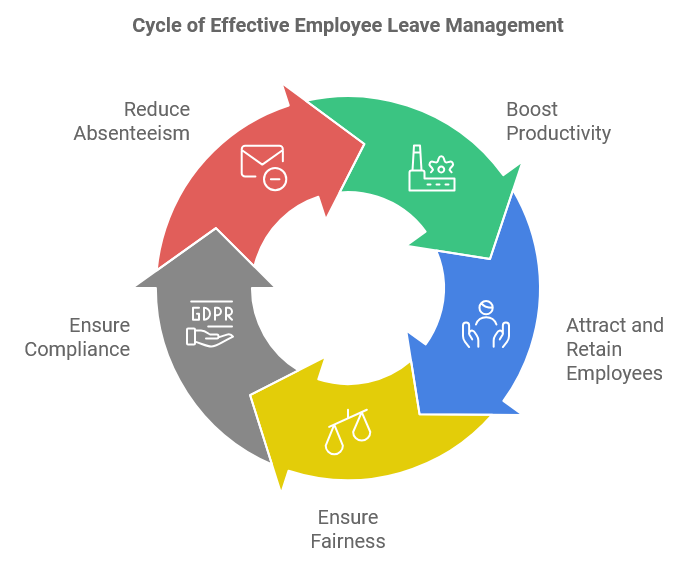
Employees need time off to recuperate and rest. But you need to manage employees’ leave effectively because:
Leave boosts productivity
A good leave management policy ensures your employees are happy, recharged, and working at their peak. Ensuring your employees receive all the leave they are entitled to improves their well-being. It makes them happier, more engaged and boosts their productivity.
Also, properly managing employee leave keeps your team staffed with enough employees. This ensures your productivity level never drops.
It affects the ability to attract and retain employees
According to research by Project: Time Off, employees consider paid time off as the second-most important benefit offered by their employer. If you don’t properly manage absence, employees won’t enjoy working for your organization, and you will have a hard time filling open positions because of a tainted employer brand.
Leave management ensures fairness
Leave management helps you apply your leave policies consistently throughout the organization, avoiding any unfairness that could affect employee morale.
Leave management policy ensures compliance
A robust leave management policy should consider local, state, and federal labor laws regarding employee time off. This will ensure compliance with applicable laws and keep you out of legal trouble.
It reduces absenteeism
Ensuring your employees are well-rested promotes their health and prevents burnout. Refreshed and recharged employees are a robust tool to reduce absenteeism.
The Complexity of Leave Management in a Hybrid Work Model
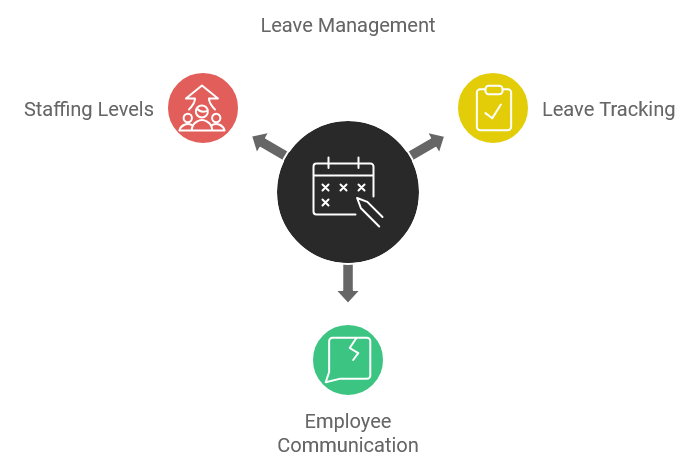
A company that switches to a hybrid work model will face the following challenges if they try to manage employee leave using the same old methods:
Leave tracking
The hybrid work model cannot work with the same processes and policies used for an on-site workforce. It will be hard to track leave time, leading to staff shortages and work buildups.
Employee communication
Hybrid employees are usually on and off at different times or time zones. The methods used to communicate policy changes or notify employees about who is out and when they will be back are different for them. You will need an almost complete overhaul of the on-site communication methods to communicate with them effectively.
Leave request and approval
In-office employees could ask for time off in person with their manager. But remote employees cannot do that. You need a digital process for managing leaves in a hybrid team. This means employees, managers and HR folks need to use an open system to apply, approve, and track leaves.
Managing staffing levels
Remote employees work in different time zones. This creates a unique challenge for managing staffing levels for different functions. Think of customer support function in a software company. It can be a challenge to ensure coverage should more employees from one time zone go on leave at the same time. Managers and HR leaders need to develop policies to ensure employees can take leave without reducing coverage of functions and time zones
Results of Poor Leave Management
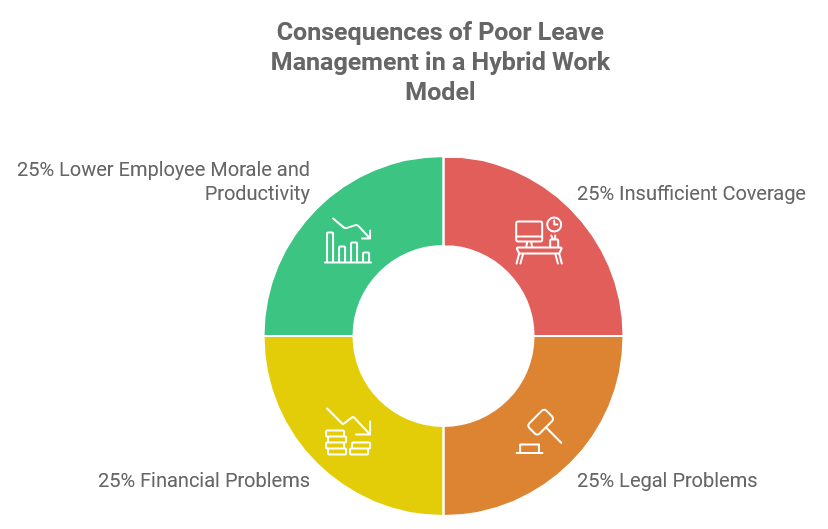
If you don’t adapt your leave management strategies to match the hybrid work model, it could lead to:
- Insufficient Coverage
- Legal problems through non-compliance with labor laws
- Financial problems
- Lower employee morale and productivity
Elements of a Good Leave Management Policy for Hybrid Teams
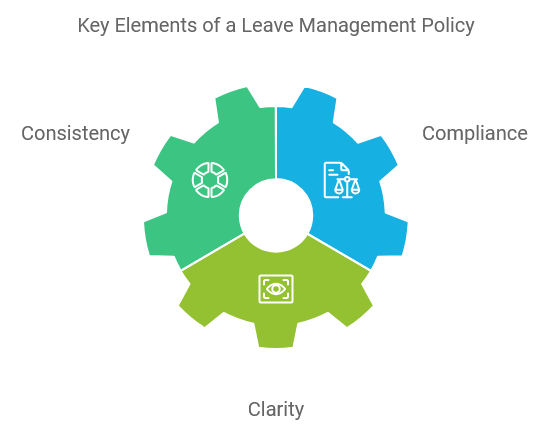
A leave management policy is a collection of rules and regulations that guide employees on leaves they are entitled to and how often they can take them. It helps employees and employers understand how time off is managed, organized, and regulated, so they can effectively plan their leaves.
A good leave management policy must have:
1. Consistency
You must apply the leave policy consistently throughout the organization. The leave policy should specify differences in leave policies for full-time and contingent or on-site and remote teams to prevent confusion.
2. Compliance
Your employee leave policy must comply with government regulations across all countries/states where you have employees or contractors. Hybrid teams can have members living anywhere in the world. So, it’s important that you continuously update your policy whenever you hire a new remote employee.
3. Clarity
Your employee onboarding process must cover leave management policy. All new employees should get a copy of the policy. The document should cover leave entitlement and the process for leave application. The HR team should communicate all policy updates to employees immediately, so everyone knows about the changes.
Since hybrid teams have employees working in office and remotely, it’s important to use multiple communication channels with employees.
Why You Need a Good Leave Management System
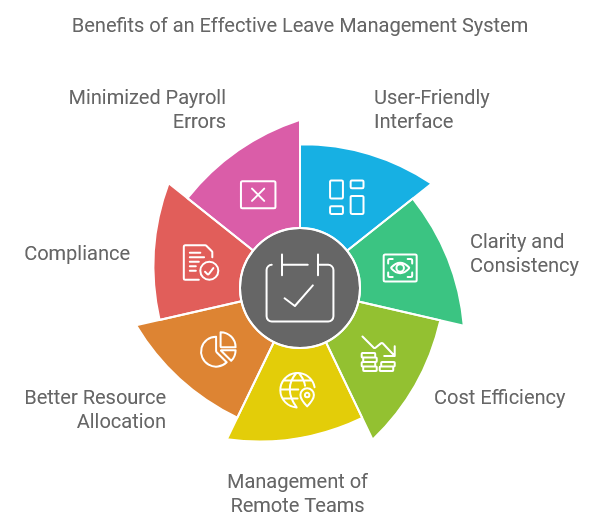
A good leave management system is essential when managing a hybrid workforce. The HR department has several responsibilities when managing employees’ time off, which get more complex with a remote team distributed across multiple locations.
Without a sound leave management system, the HR department will have a hard time organizing time off, creating disquiet in the workforce.
A good leave management system allows you to effectively manage leaves for the hybrid workforce by eliminating the complexities we discussed:
1. Leave management system easy to use for all teams
For an on-site workforce, requesting a leave of absence is easy because they can do it in person. But for a distributed workforce, a good leave management system is the only option.
A leave management system allows remote employees to request leaves through the system. It is faster and more convenient than other methods of requesting remotely, such as email. A leave management system also allows employees to see the number of days they have available before requesting leave.
It helps HR professionals streamline absence by letting them set working days, leave duration, and different leave policies for different workers. They can approve a request from within the app, see a consolidated view of the vacations of the whole workforce, and leave it to the system to auto-update the leave balance.
2. Leave management system ensures clarity and consistency
With a leave management system, employees know how to check the status of their vacation days, how to request leave, and how the approval process works. Employees get to know immediately whether the leave is accepted or rejected. The reduced uncertainty improves their performance and productivity.
The HR team has a simple process of checking and approving or denying leave requests. They can quickly check the leave policy applicable to the requester before denying or approving it. They can also view all the leave information in a single dashboard, so they don’t have to dig through file cabinets or spreadsheets to find specific information.
Line managers can also use the leave management system to stay on top of their team’s leave requests and availability.
3. It is cost efficient
A good leave management software helps your organization save time and money. Improved process and documentation save time and money.
A good system also saves trouble and money by helping your business stay compliant with all applicable regulations.
4. It helps with the management of remote international teams
Organizations with operations in more than one country need powerful leave management software that considers the difference in time zones. A good system also considers the national holidays in the country.
5. Leads to better resource allocation
An organization needs clarity on the capacity of its team to allocate tasks and resources effectively and efficiently. A good leave management system allows them to see which employees are on leave and which are working. This will enable them to replace and distribute tasks according to their capacity efficiently.
It also helps avoid bottlenecks caused by poor leave management.
6. It ensures compliance
If there are any local, state, or federal policies that employers are supposed to comply with, a sound system ensures you remain compliant. It updates you on any changes in employment laws that affect leaves, protecting your business.
7. Leave management system minimizes payroll errors
Some leaves are paid, and others aren’t. A good system allows you to distinguish which employee is on what leave, eliminating any risk of making an error when paying.
Importance of Tracking Time for Effective Leave Management
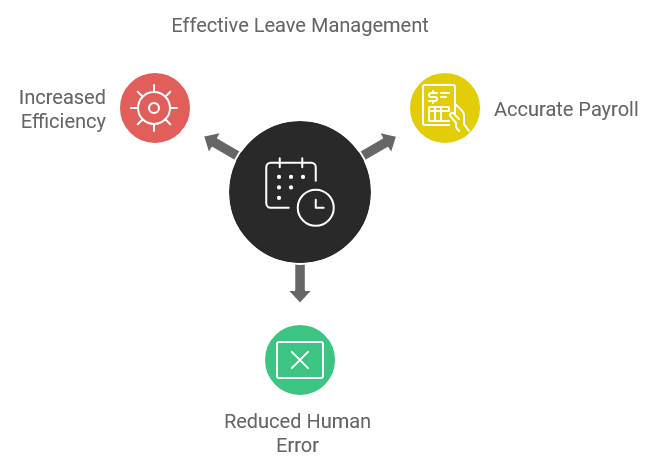
A good leave management system also allows you to track your employees’ leave time. It is more accurate and much faster than doing it manually, and it automatically updates leave balances and other details, leaving you with less repetitive tasks.
If you track your employees’ time more effectively, you can calculate the payroll more accurately. Time tracking ensures you compensate employees only for hours worked and applicable paid time off. You won’t have to look for attendance sheets and leave files to calculate; it only takes a few seconds.
Tracking time also reduces human error and eliminates the risk of fraud, such as overestimating hours and altering timesheets. The better you track time, the more efficient your employees and organization will be.
Boost Your Teams' Productivity with Time Tracking Software
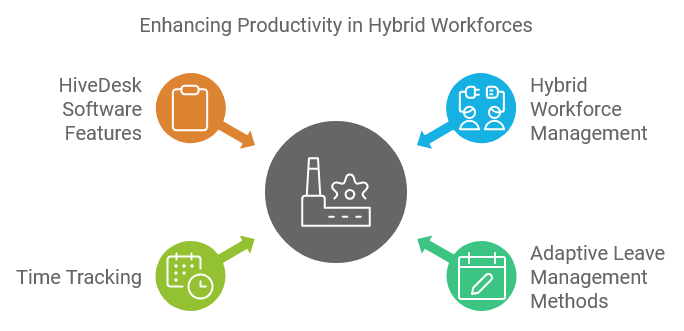
The procedure of managing leaves for a hybrid workforce differs from that of managing leaves for an on-site workforce. It presents challenges and complexities that could lead to staff unavailability, lower employee morale, reduced productivity and legal issues.
The only way to beat challenges and maintain or improve the productivity of your workforce is by adapting your leave management methods to match the hybrid work model. Time tracking is at the core of an effective hybrid team leave management strategy. It enables you to track when they are off and on for better workflow management and salary calculation.
A time tracking software like HiveDesk allows you to track time for both in-office and remote workers to boost your leave management efforts. It will enable you to track tasks and leaves to increase your team’s productivity. It also allows multi-level access management and automatically takes screenshots of your employees’ screens periodically to monitor their activity.
Try HiveDesk today to boost your team’s productivity.

